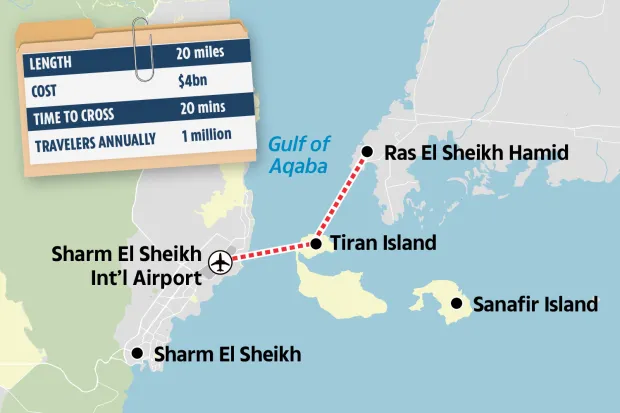Bricks, steel, and audacious vision are being used to mend a continent that was previously split apart by colonial borders, not just through treaties and trade agreements. Egypt and Saudi Arabia have made history by finalizing plans for the "Moses Bridge", a $4 billion Red Sea crossing. The timing of this enormous infrastructure project, which will build the first land bridge between Africa and Asia, couldn't be more advantageous.
As AfCFTA continues to unfold, aiming to create the world’s largest free trade area by population, the Moses Bridge represents a powerful enabler: physical connectivity to match political ambition.
 Pic courtesy: The U.S. Sun
Pic courtesy: The U.S. Sun
From Biblical Symbolism to Continental Strategy
The Moses Bridge, named after the legendary route of exodus, will stretch over 30 kilometers from Sharm El-Sheikh in Egypt to Ras Al-Sheikh Hamid in Saudi Arabia. But its real significance lies not in its name but in its promise.
By linking the African continent directly to the Gulf region and Asia beyond, the bridge opens new arteries for trade, shortens supply chains, and deepens Africa’s integration into global logistics systems.
What It Means for AfCFTA
- Trade Growth Outside of Africa: Although intra-African trade is the main goal of the AfCFTA, its success hinges on how well Africa integrates with the rest of the world. Through a northern gateway, this bridge increases export capacity and makes it simpler for AfCFTA entrepreneurs to reach markets in Asia and the Middle East.
- Logistics Cooperation with the Lobito Corridor: Egypt is constructing its own eastern superhighway while Angola, Zambia, and the Democratic Republic of Congo work on the Lobito rail corridor on Africa's western flank. When combined, they serve as pan-African supply chain corridors, with Moses Bridge serving as a vital hub for logistics in the Red Sea.
- North African Industrial Hubs' Gateway: Egypt now has a direct overland route to Saudi and Asian demand for its industrial zones, which include textiles, agriculture, and energy. Under the AfCFTA, MSMEs can start investigating new export models since freight times and tariffs have decreased.
- Travel, Pilgrimage, and Intercultural Communication: In addition to facilitating trade, the bridge will facilitate the journey of millions of African pilgrims to Saudi Arabia. It will also increase cross-cultural tourism, a sector that the AfCFTA is aiming to boost for jobs and recovery.
The Moses Bridge is more than just an amazing piece of engineering. It shows what AfCFTA could become: not just a paper agreement but a network of roads, rails, fibre lines, and trade routes that could change Africa's economic future.
Africa needs to make smarter connections so that it can trade more with itself and with the rest of the world. One of these is this bridge.